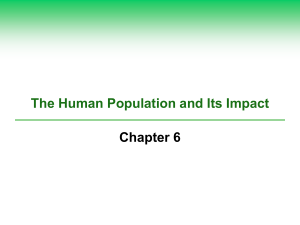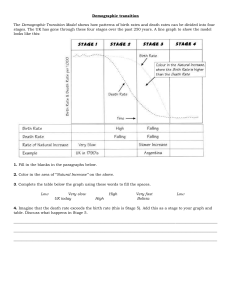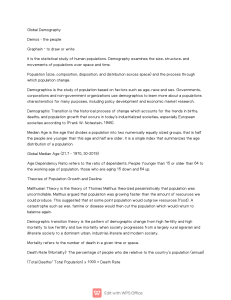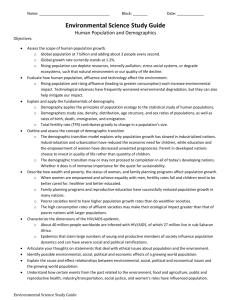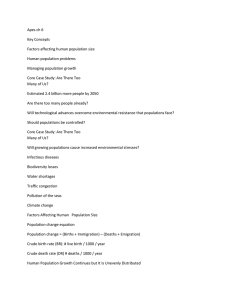Human Populations
advertisement
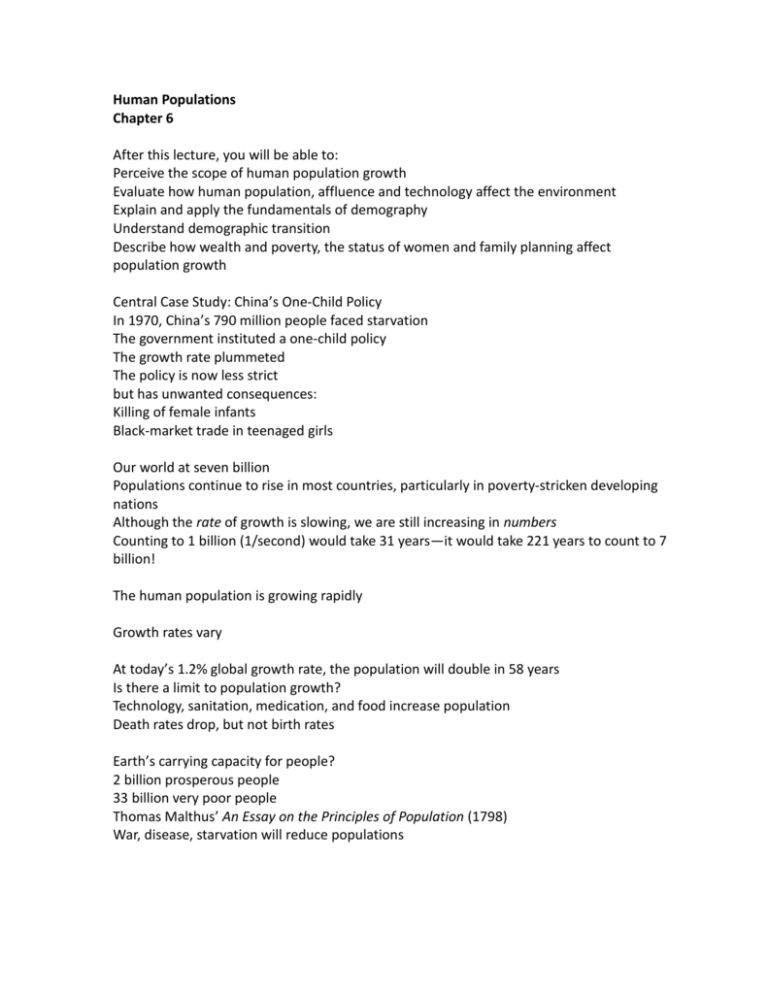
Human Populations Chapter 6 After this lecture, you will be able to: Perceive the scope of human population growth Evaluate how human population, affluence and technology affect the environment Explain and apply the fundamentals of demography Understand demographic transition Describe how wealth and poverty, the status of women and family planning affect population growth Central Case Study: China’s One-Child Policy In 1970, China’s 790 million people faced starvation The government instituted a one-child policy The growth rate plummeted The policy is now less strict but has unwanted consequences: Killing of female infants Black-market trade in teenaged girls Our world at seven billion Populations continue to rise in most countries, particularly in poverty-stricken developing nations Although the rate of growth is slowing, we are still increasing in numbers Counting to 1 billion (1/second) would take 31 years—it would take 221 years to count to 7 billion! The human population is growing rapidly Growth rates vary At today’s 1.2% global growth rate, the population will double in 58 years Is there a limit to population growth? Technology, sanitation, medication, and food increase population Death rates drop, but not birth rates Earth’s carrying capacity for people? 2 billion prosperous people 33 billion very poor people Thomas Malthus’ An Essay on the Principles of Population (1798) War, disease, starvation will reduce populations Different views on population growth Paul Ehrlich’s The Population Bomb (1968) predicted that population growth would lead to famine and conflict But intensified food production fed more people Many economists think depleted resources will be replaced or new resources created But many resources (e.g., species) cannot be replaced Quality of life will suffer with unchecked growth Population growth: causes and consequences Several factors affect the environment The IPAT model: I = P A T Our total impact (I) on the environment results from: Population (P) Affluence (A) Technology (T) Further model refinements include the effects of education, laws, and ethics on the formula Demography Demographers study: Population size Density and distribution Age structure Sex ratio Birth, death, immigration, and emigration rates Population size and density The UN predicts 9 billion humans by 2050 If women have just 0.5 children fewer than the medium scenario, there will be 8, not 9.15, billion by 2050 Population distribution Age structure affects population size Many populations are aging The global mean age is now 28—in 2050, it will be 38 Factors in population change Rates of birth, death, and migration determine whether a population grows, shrinks, or remains stable Birth and immigration add individuals Death and emigration remove individuals Technological advances cause decreased deaths The increased gap between birth and death rates resulted in population expansion Natural rate of population change is the change due to birth and death rates alone, excluding immigration and emigration Eighty million added per year despite falling growth rates Factors affecting total fertility rate Total fertility rate (TFR) is the average number of children born to each female during her lifetime Replacement fertility is the TFR that keeps the size of a population stable (about 2.1) Causes of decreasing TFR: Medical care reduces infant mortality Urbanization increases childcare costs Children go to school instead of working Social Security supports the elderly Educated women enter the labor force Life expectancy is increasing People live longer in countries with good sanitation, health care, and food Urbanization, industrialization, and personal wealth increases life expectancy (the time a person can expect to live) and decreases infant mortality Demographic transition is a model of economic and cultural change Explains the declining death and birth rates in industrializing nations The demographic transition As they industrialize, nations move from a stable pre-industrial state of high birth and death rates to a stable post-industrial state of low birth and death rates Industrialization decreases mortality rates Death rates fall before birth rates Resulting in temporary population growth 4 stages of demographic transition Pre-industrial stage: low population growth High death (disease, starvation, few medicines) and birth (compensation for mortality) rates Transitional stage: industrialization, increased food and medical care reduce mortality rates High birth rates cause population to surge Industrial stage: women get jobs and use birth control Post-industrial stage: low birth and death rates stabilize populations Is demographic transition universal? It has occurred in Europe, the U.S., Canada, Japan, and other nations over the past 200–300 years But it may or may not apply to developing nations The transition could fail: If the population is too large to allow the transition In cultures that place greater value on childbirth or grant women fewer freedoms Family planning is the key to controlling growth Birth control reduces the frequency of pregnancy Contraception is the deliberate prevention of pregnancy through a variety of methods Hindered by religious and cultural influences Rates range from 10% (Africa) to 86% (China) Empowering women reduces fertility rates A nation’s fertility rates drop when women gain access to contraceptives, family planning programs, and educational opportunities Educating women reduces fertility rates, delays childbirth, and gives them a voice in reproductive decisions A woman controls her reproductive window Jobs or school delays the birth of a first child Contraceptives space births The window is “closed” after the desired number of kids Family planning reduces fertility rates Poverty and population growth are related Poor societies have higher population growth rates Poverty and population growth make each other worse Projected population growth Wealth also impacts the environment Affluent societies have enormous resource consumption One American has as much environmental impact as 3.5 Chinese or 9 Indians or 13 Afghans We must reduce population growth and consumption

